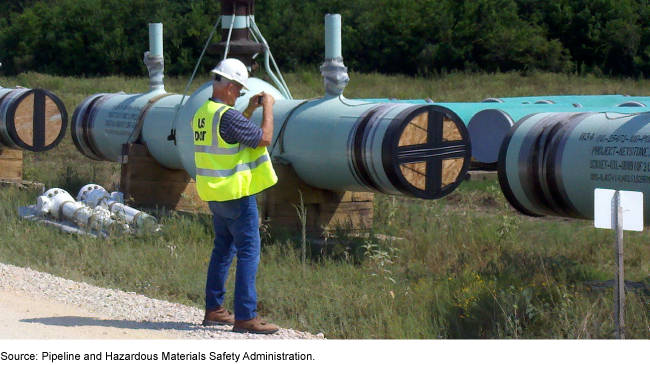Pipeline Safety: Fully Implementing Key Practices Could Help Improve Transparency of Enforcement Website
Fast Facts
The Pipeline and Hazardous Materials Safety Administration inspects interstate natural gas and hazardous liquid pipelines, investigates accidents, and enforces laws and regulations.
The agency puts information about its enforcement activities on its public Enforcement Transparency website. We found that the website generally aligned with key practices for transparently reporting government data, but the agency could make some improvements. For example, a better search tool could let users filter the data by type of regulation violated or other characteristics.
We recommended that the agency optimize the website's search function, and more.

Highlights
What GAO Found
Pipeline and Hazardous Materials Safety Administration (PHMSA) officials inspect pipelines and investigate accidents. These officials can issue a range of enforcement actions if they identify unsafe conditions or non-compliance with laws or regulations. PHMSA records enforcement information in an electronic records system, and uploads documents and related data to its public Enforcement Transparency website. GAO found that this website fully met two of five key practices that GAO identified for transparently reporting open government data and partially met another three. (See figure.) Open data can foster accountability and public trust by providing citizens with information on government activities and their outcomes. PHMSA officials stated that they would like to improve the website for users, but are first focusing on improving the electronic records system. Nevertheless, fully implementing these key practices could assist PHMSA with transparently presenting enforcement information and help users find the information they need.
Key Practices for Transparently Reporting Open Government Data and the Pipeline and Hazardous Materials Safety Administration's (PHMSA) Enforcement Transparency Website
|
Key practices |
Website characteristics |
|---|---|
|
Engage with users |
Met. PHMSA officials discuss the use of the website with users, including pipeline operators and the public, and provide a link on the website for users to submit feedback or questions. |
|
Fully describe the data |
Met. PHMSA's website provides labels and descriptions of the enforcement data and tables. Metadata and licensing information for these data are available on a central Department of Transportation website. |
|
Provide free and unrestricted data |
Partially met. PHMSA's website and the data it contains are available to the public at no cost. However, PHMSA does not publish complete data on its website. For example, PHMSA's enforcement documents include variables that indicate whether the pipeline involved is interstate or intrastate, but PHMSA does not make these variables available in the enforcement dataset. |
|
Provide data in useful formats |
Partially met. PHMSA allows users to view and download disaggregated data on all enforcement activities. However, users are unable to download a bulk dataset of all enforcement activities from 2002 to 2022. Additionally, users cannot easily match records from the enforcement website with records in PHMSA's accident dataset. |
|
Facilitate data discovery for users |
Partially met. PHMSA facilitates data discovery by providing users with overviews and definitions of the enforcement information published on the website, and provides national summaries of the data. However, PHMSA does not provide an optimized search tool that allows users to filter by discreet variables, such as the regulation violated. |
Source: GAO analysis of PHMSA website and key practices. | GAO-23-105537
Why GAO Did This Study
Accidents on interstate natural gas and hazardous liquid pipelines can release large amounts of these products, potentially injuring or killing people and damaging the environment. In 2007, PHMSA launched the Enforcement Transparency website to address concerns about the transparency of its pipeline safety enforcement actions.
The Protecting our Infrastructure of Pipelines and Enhancing Safety Act of 2020 includes a provision for GAO to review information on pipeline enforcement actions that PHMSA makes publicly available on the internet. This report addresses (1) PHMSA's process to record pipeline safety enforcement information, and what information PHMSA makes publicly available, and (2) the extent to which its pipeline enforcement website aligns with key practices for transparently reporting data.
GAO reviewed relevant statutes, regulations, and agency guidance on recording and publishing pipeline safety enforcement information. GAO compared PHMSA's Enforcement Transparency website with leading practices for transparently reporting government data that GAO previously identified, and interviewed PHMSA officials and stakeholders.
Recommendations
GAO makes three recommendations to improve the transparency and usability of PHMSA's Enforcement Transparency website, specifically to provide complete data in more useful formats, to improve matching with other PHMSA datasets, and to optimize the website's search function. DOT concurred with GAO's recommendations.
Recommendations for Executive Action
| Agency Affected | Recommendation | Status |
|---|---|---|
| Pipeline and Hazardous Materials Safety Administration | The Administrator of PHMSA should update PHMSA's Enforcement Transparency website to provide complete, machine-readable data that can be downloaded in bulk and in selected subsets. (Recommendation 1) |
Accidents on interstate natural gas and hazardous liquid pipelines can release large amounts of these products, potentially injuring or killing people and damaging the environment. The Pipeline and Hazardous Materials Safety Administration (PHMSA) inspect pipelines, investigates accidents and can issue a range of enforcement actions if it identifies unsafe conditions or non-compliance with laws or regulations. PHMSA records enforcement information in an electronic records system, and uploads documents and related data to its public Enforcement Transparency website, which was launched in 2007 to address concerns about the transparency of its pipeline safety enforcement actions. GAO compared PHMSA's Enforcement Transparency website with key practices for transparently reporting government data that GAO previously identified. In 2022, GAO reported that PHMSA did not fully align with two key practices for transparently reporting data. Specifically, PHMSA did not fully provide free and unrestricted data or provide data in useful formats. PHMSA collects and records data on over 200 variables that describe each enforcement case. However, not all variables are published in the dataset on the Enforcement Transparency website. Key practices suggest that making government data open by default can minimize the burden on agencies of responding to information requests. Additionally, providing complete, open data ensures the data are equally open to all types of users. GAO also found that users of PHMSA's Enforcement Transparency website could not download a bulk dataset for all cases opened by PHMSA from 2002 (the first year of data available on the website) through the time of GAO's report. Additionally, making data available to download in bulk allows users who need the full dataset or selected subsets to access that information easily, rather than retrieving it record by record. Therefore, GAO recommended that PHMSA update its Enforcement Transparency website to provide complete, machine-readable data that can be downloaded in bulk and in selected subsets. In 2023, GAO confirmed that PHMSA has uploaded the enforcement raw data (i.e., complete data) and the associated data dictionary to its Enforcement Transparency website. According to PHMSA officials, the raw data will be updated monthly, while the data dictionary will be updated on an as needed basis. By making these data readily available, PHMSA has improved the usefulness and transparency of the website. Specifically, enabling users to analyze data from multiple years or filter out cases not needed for analyses, which will minimize PHMSA's burden of responding to information requests.
|
| Pipeline and Hazardous Materials Safety Administration | The Administrator of PHMSA should update PHMSA's enforcement data to be interoperable with other relevant datasets, such as PHMSA's accident-incident dataset (e.g., by adding a unique identifier variable.) (Recommendation 2) |
Accidents on interstate natural gas and hazardous liquid pipelines can release large amounts of these products, potentially injuring or killing people and damaging the environment. The Pipeline and Hazardous Materials Safety Administration (PHMSA) inspect pipelines, investigates accidents and can issue a range of enforcement actions if it identifies unsafe conditions or non-compliance with laws or regulations. PHMSA records enforcement information in an electronic records system, and uploads documents and related data to its public Enforcement Transparency website, which was launched in 2007 to address concerns about the transparency of its pipeline safety enforcement actions. GAO compared PHMSA's Enforcement Transparency website with key practices for transparently reporting government data that GAO previously identified. In 2022, GAO reported that PHMSA did not fully align the key practice of providing data in useful formats, for example by making the data interoperable with other datasets. Specifically, users could not easily match records on PHMSA's Enforcement Transparency website with other relevant PHMSA datasets, such as the accident-incident dataset because there was no shared variable between the datasets that would allow them to do so. Making the enforcement data interoperable with other datasets, for example by including a unique identifier variable that would allow users to match enforcement case data with accident data, could make them more useful by creating new opportunities for analysis by linking datasets together. As a result, GAO recommended that PHMSA update its enforcement data to be interoperable with other relevant datasets, such as PHMSA's accident-incident dataset (e.g., by adding a unique identifier variable.) In 2023, GAO confirmed that PHMSA had added unique incident numbers to the posted enforcement raw data, which provided users the ability to associate enforcement cases to other publicly available datasets, such as PHMSA's incident and activity datasets. Adding these unique incident numbers improves the usability and transparency of PHMSA's enforcement data. For example, stakeholders can now connect the enforcement and accident datasets to understand if an accident resulted in PHMSA taking an enforcement action.
|
| Pipeline and Hazardous Materials Safety Administration | The Administrator of PHMSA should update PHMSA's Enforcement Transparency website to provide a search function that allows users to find relevant information, which could include the ability to search by the regulation violated. (Recommendation 3) |
Accidents on interstate natural gas and hazardous liquid pipelines can release large amounts of these products, potentially injuring or killing people and damaging the environment. The Pipeline and Hazardous Materials Safety Administration (PHMSA) inspect pipelines, investigates accidents and can issue a range of enforcement actions if it identifies unsafe conditions or non-compliance with laws or regulations. PHMSA records enforcement information in an electronic records system, and uploads documents and related data to its public Enforcement Transparency website, which was launched in 2007 to address concerns about the transparency of its pipeline safety enforcement actions. GAO compared PHMSA's enforcement website with key practices for transparently reporting government data that GAO previously identified. In 2022, GAO reported that PHMSA did not fully align with one key practice for transparently reporting data. Specifically, PHMSA did not fully facilitate data discovery for all users, for example by providing a search function that is optimized for easy and efficient use. PHMSA's enforcement website allowed users to sort the enforcement data by operator name, but users were unable to search with other key terms or variables. Having such a search function would allow users to find information that is relevant to their interests. For example, one stakeholder noted that the ability to search by the regulation violated would allow users to identify all enforcement actions for the particular safety issue with which they are concerned. If users had access to a complete enforcement data file, they could more efficiently search PHMSA records by filtering data instead of searching individual records. Additionally, a more robust search function would enable users to more easily identify specific cases for their own purposes. Therefore, GAO recommended that PHMSA update its Enforcement Transparency website to provide a search function that allows users to find relevant information, which could include the ability to search by the regulation violated. In 2023, GAO confirmed that PHMSA had taken sufficient action to close this recommendation. Specifically, PHMSA updated its enforcement website to provide enforcement data in raw format (i.e., complete data) that can be searched. Making the raw enforcement data searchable by variables-such as the regulation violation-PHMSA has enhanced the ability of users to search its enforcement website and find the relevant information they need to analyze data and identify trends.
|





